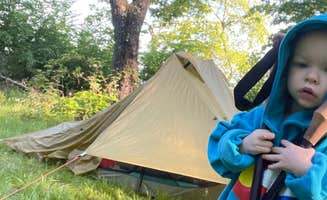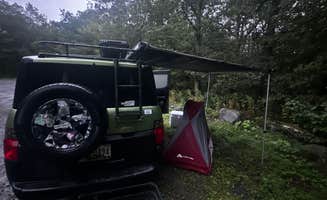Dispersed camping near Walnutport, Pennsylvania provides access to sections of the Blue Mountain ridge at elevations between 1,300-1,600 feet. The area features rocky terrain with mixed hardwood forests dominated by oak, maple, and hickory trees. Summer temperatures average 75-85°F during day and 55-65°F at night, while spring and fall bring significant temperature variations requiring adaptable gear.
What to do
Hike to elevated viewpoints: From Bake Oven Knob, campers can access a rocky trail leading to panoramic views. "The hike to the overlook is really lovely; short and rocky," notes Dani T., who frequently parks overnight in their van at this location.
Explore extensive trail systems: The Thunder Swamp Trailhead connects to multiple hiking routes through dense forest areas. Jason R. reports, "Tons of hiking. Went down Saw Creek trail to a marsh." This area serves as a gateway to several interconnected trails of varying difficulty levels.
Wildlife observation opportunities: Dawn and dusk hours offer the best wildlife viewing times throughout the Appalachian corridor. Early morning hikers frequently spot deer, wild turkeys, and various bird species. Seasonal considerations affect wildlife activity patterns, with spring and fall migrations bringing diverse bird species through the area.
What campers like
Natural isolation: Campsites along the Appalachian Trail corridor provide separation from developed areas. At Appalachian Trail- Designated Backpacker Campsite 2, Katharine T. found "plenty of space. We camped nearer to others but there are secluded spots too."
Hammock-friendly terrain: Many dispersed sites feature suitable trees for hammock setups. Renee Z. reports that while the Appalachian Trail Designated Backpacker Campsite 2 may be "a little on the small and sloped side for tent camping, but I was in a hammock and it was a great place for that!"
Safety features: Some backcountry sites include bear prevention infrastructure. Katherine T. noted the Appalachian Trail Designated Backpacker Campsite 2 is "well maintained w bear boxes provided. Good trees for hammocking."
What you should know
Water availability limitations: Most dispersed sites lack reliable water sources. Renee Z. advises about Appalachian Trail- Designated Backpacker Campsite 2: "There's no water nearby... Stock up on water at the Dunnfield creek natural area, or wait until Sunfish pond." Campers should plan to carry sufficient water or research collection points.
Fire restrictions: Ground fires are prohibited at most dispersed sites in the region. Campers should bring alternative cooking methods such as camp stoves. Check current fire restrictions as they may change seasonally or during drought conditions.
Overnight parking regulations: Vehicle-accessible options exist but have specific limitations. Benjamin H. describes Thunder Swamp Trailhead as "a gravel parking lot. Plenty of shade. No one bothered me," indicating informal overnight parking is tolerated but not officially designated.
Tips for camping with families
Site selection considerations: Choose locations with flat terrain and proximity to points of interest. Campsite 2 on the Appalachian Trail includes both communal and private options, with Katharine T. describing it as a "perfect balance of community and space."
Food storage requirements: Bear activity necessitates proper food storage. The Appalachian Trail Designated Backpacker Campsite 2 provides bear boxes, but at other sites, families need to bring bear-resistant containers or prepare to hang food supplies.
Trail difficulty assessment: Thunder Swamp Trailhead connects to trails with varying difficulty levels suitable for different age groups. Jason R. described his experience as "chill" with opportunities for shorter hikes to interesting features like marsh areas.
Tips from RVers
Overnight parking options: Some trailheads accommodate vans and smaller RVs for brief stays. Dani T. reports, "I've overnighted in my van here a bunch, no problems" at Bake Oven Knob, which features "two large lots" suitable for parking.
Limited facilities: Dispersed sites lack hookups or dumping facilities. RVers must be self-contained with sufficient water, power, and waste storage capacity for their planned stay duration.
Shade considerations: When selecting parking locations, assess sun exposure. Benjamin H. noted that Thunder Swamp Trailhead offers "plenty of shade," which helps maintain comfortable interior temperatures without running air conditioning systems.



